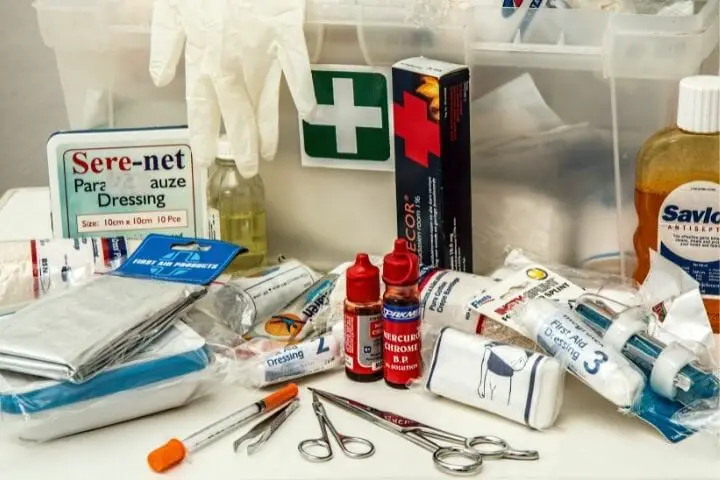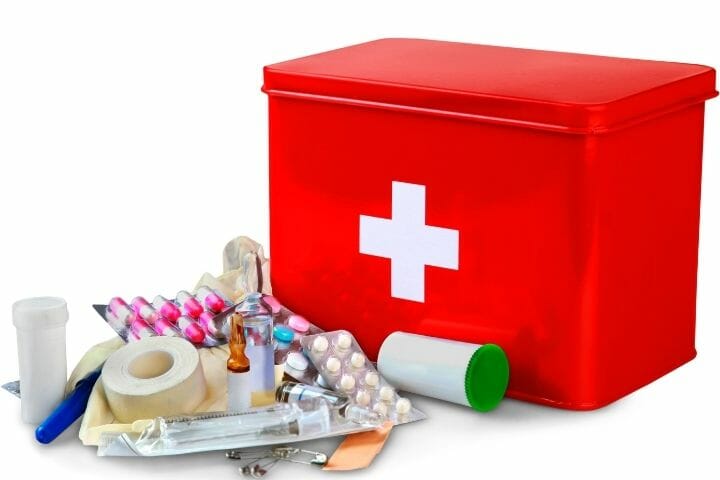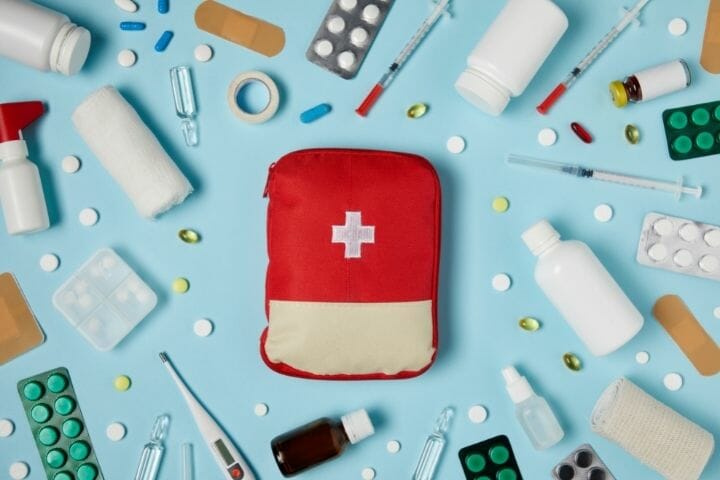You can easily take care of cuts, bruises, and minor injuries if you have a good first aid kit. Let’s look at some must haves for a first aid kit at home.
Contents
Every child’s ouchie can usually be made better with the application of a Band-Aid and a kiss from their mother, but being prepared for any life’s peaks and pitfalls, as well as injuries and illnesses, is critical at any age.
According to the CDC, accidental injuries contributed to approximately 39.4 million doctor visits and 24.6 million emergency room visits in 2016.

Being ready with a first aid pack and suitable treatments for minor cuts, scratches, burns, and sprains can be the difference between life and death.
There are pre-made first aid kits available, but you can also put together your own and customize it to your family’s and workplace’s specific requirements. Make sure to include these products in your first aid kit.
Containers
You should use a watertight container for this step. You may require a soft pouch with several compartments to keep your items in order. You can use an old backpack to create one.
You should choose a bag with elastic straps, a drawstring bag, and a roomy compartment for minor supplies. Plastic bags and pill bottles, as well as a marker to identify them, may also be needed in addition to a waterproof bag.
Personal Items
It is crucial to record all of your family members’ phone numbers and emergency numbers like doctors and hospitals in case of an emergency.
Keep a few doses of medicine or insulin on hand if you or a family member needs them. If you forget or cannot get to the pharmacy to pick up the medicines, you will have home supplies.
Some pointers for storing pharmaceuticals in an emergency kit include the following:
- To ensure that you have all of the information you need, keep your medicines in their original packaging. This includes the dose and warnings and the pharmacy’s contact information.
- Do not use drugs that have passed their expiry date. You must change some items out on a six-month basis.
- You should store insulin in a cool environment. You can even personalize the outside of your kit with a sticky note to remind you to fetch your insulin from the refrigerator during a hectic morning.

Ointments and creams
Aloe vera gel and anti-itch lotion are essentials in any first aid kit. Using aloe vera gel to soothe and heal burned skin is necessary since it hydrates the skin while relieving irritation and reducing the risk of blood loss.
You may effectively treat insect bites and rashes with cortisone due to its anti-inflammatory and anti-redness effects.
Antiseptics
Washing wounds and injuries as soon as possible will help avoid the spread of bacteria and skin irritations. Make sure to include antibacterial soap, hydrogen peroxide, and a pain reliever in your first aid bag.
Rinse your hands thoroughly with soap and apply hydrogen peroxide to a wound before treating it. You might use antiseptic wipes or a liquid topical solution. You can also use alternatives to hydrogen peroxide for those sensitive to it.
Wraps and Bandages
Every first aid kit needs many bandages and wraps to cope with small cuts, burns, scrapes, and bruises. If you have a minor injury, you can save money by treating it at home instead of going to the doctor.
An assortment of adhesive bandages, gauze for deeper wounds, an aluminum splint for support of broken or sprained limbs, and athletic tape to protect fragile joints should be included in your first aid kit for treatment and bleeding control.
Pain Killers
Pain medications are a must to alleviate the pain caused by an accident or disease. Aspirin, ibuprofen, acetaminophen, and aspirin-free pain medication are all good options to have on hand.

General Medicines (OTC’s)
Every time you go out to eat, you’re at risk of getting food poisoning, and one never knows when they’ll acquire the flu or experience an allergic response. Over-the-counter medications can help alleviate your symptoms whenever you.
If you get heartburn, indigestion, or an upset stomach, have antacid pills and Pepto-Bismol on hand in your first aid box. Sneezing, itching, and a runny nose can all be alleviated with the use of antihistamines, which are prescribed to those who suffer from seasonal allergies.
Medical equipment
A few basic medical supplies are necessary for a first aid pack. A thermometer is essential for keeping track of your temperature and determining whether or not you should see a doctor.
Splinters and other tiny foreign items can be easily removed with tweezers. You’ll also need a pair of blunt-tip scissors to avoid harming yourself while removing bandages and gauze, as well as an immediate cold compress to ease any discomfort and pain.
First Aid and Self Care
Self-care entails taking measures to prevent sickness and harm in everyday life by adopting a healthy lifestyle and being mindful of your activities.
When you have a mild sickness or injury, taking care of yourself at home is an important part of self-care. Being sick less often allows you to spend more time with your loved ones and do the activities you like.
Here are some tips to take care of yourself:
- Eating a balanced diet rich in nutrients
- Maintaining a regular exercise routine.
- Reducing your intake of alcoholic beverages
- The decision to stop smoking
- Taking care of your own emotional well-being
- Keeping a healthy mouth, teeth, and gums.

Wrap Up
Once you’ve put together your first aid kit, make sure to maintain it well-stocked and up-to-date. Check your resources every six months and replenish or substitute as necessary.
If you have children, educate them on utilizing the medical supplies in your first aid kit and keeping it in an easily accessible place. A completely built first aid kit can treat injuries right away and put minor aches and pains to rest.
Please let us know if there’s anything you think we’ve missed or if you have any suggestions for how we can improve this guide. Please share it with others and mention us on your social networking sites if you appreciate the information.
